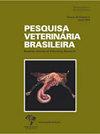Epidemiological analyses of cattle carcasses affected by cysticercosis and hydatidosis in the State of Rio Grande do Sul from 2014 to 2018
IF 0.8
4区 农林科学
Q3 VETERINARY SCIENCES
引用次数: 3
Abstract
ABSTRACT: Bovine cysticercosis and hydatidosis are frequently identified by inspectors in slaughterhouses from the state of Rio Grande do Sul. Slaughterhouse records can provide valuable information for animal-related diseases and public health surveillance. Analyzing these data can aid set priorities to regions or properties that need more attention. Slaughter condemnation data is collected daily and stored in the Agricultural Defense System (SDA) database of the State Veterinary Services. However, it needs to be turned into useful information in bovine cysticercosis and hydatidosis surveillance programs. This study aimed to discuss how the analysis of condemnation data in the context of epidemiology can be useful for a surveillance system of bovine cysticercosis and hydatidosis. For this purpose, slaughter data of 5,137,870 cattle from 480,000 animal movement permits (GTA) from 97,891 farms from 2014 to 2018 were obtained from the Secretary of Agriculture, Livestock and Rural Development of the State of Rio Grande do Sul (SEAPDR-RS). Differences in the occurrence rates of bovine cysticercosis and hydatidosis among mesoregions over time were assessed through generalized linear models. Cysticercosis was identified in 65,379 (1.27%) carcasses and hydatidosis in 323,395 (6.29%). The occurrence rates of both diseases varied distinctly over time between the regions (p<0.01). Next, a process was developed to identify priority farms to target a surveillance program based on the prevalence. Period prevalence for cysticercosis and hydatidosis was obtained for each farm. The epidemiological indicator was calculated for each farm, dividing the number of affected carcasses by the number of bovines sent to slaughter during the period. The mean prevalence was obtained, and the exact binomial test was applied to identify farms presenting prevalence above the mean. It was observed that 2.48% and 6.17% of the farms had prevalence above the population mean prevalence of cysticercosis and hydatidosis, respectively. The Western mesoregion had the highest percentage of farms with prevalence above the average for cysticercosis (6.9%), followed by the Southwest mesoregion (6.0%). For hydatidosis, the percentage frequency of farms with prevalence above the average was markedly higher in the mesoregions Southeast (32.8%) and Southwest (29.5%). The results showed that analysis of slaughterhouse condemnation data of SDA is useful to identify situations in which the occurrence of the diseases is significantly higher than the average to apply additional measures or epidemiological investigations. This information may be useful in plans of epidemiological surveillance programs for controlling bovine cysticercosis and hydatidosis by the State’s Official Veterinary Services.2014 - 2018年南巴西大德州牛体囊虫病和包虫病流行病学分析
摘要:牛囊虫病和包虫病经常在南巴西大德州的屠宰场被检查人员发现。屠宰场记录可为动物相关疾病和公共卫生监测提供有价值的信息。分析这些数据可以帮助确定需要更多关注的区域或属性的优先级。屠宰谴责数据每天收集并存储在国家兽医服务局的农业防御系统(SDA)数据库中。然而,需要将其转化为牛囊虫病和包虫病监测计划中的有用信息。本研究旨在探讨如何在流行病学背景下分析谴责数据可用于牛囊虫病和包虫病的监测系统。为此,从南巴西大德州农业、畜牧业和农村发展部(SEAPDR-RS)获得了2014年至2018年97,891个农场48万份动物流动许可证(GTA)的5,137,870头牛的屠宰数据。牛囊虫病和包虫病的发病率随时间在各中区域之间的差异通过广义线性模型进行评估。检出囊虫65,379例(1.27%),包虫病323,395例(6.29%)。两种疾病的发病率随时间的变化在地区间差异显著(p<0.01)。接下来,制定了一个程序,以确定优先农场,并根据流行情况制定监测计划。获得了每个农场囊虫病和包虫病的流行率。计算了每个农场的流行病学指标,将受影响的胴体数除以该期间送去屠宰的牛数。获得平均流行率,并应用精确二项检验来确定流行率高于平均值的农场。调查结果显示,2.48%的养殖场囊虫病和6.17%的养殖场包虫病的患病率高于人群平均水平。西部中部地区囊虫病患病率高于平均水平的养殖场比例最高(6.9%),其次是西南中部地区(6.0%)。在中央区,东南部(32.8%)和西南部(29.5%)的养殖场患病率高于平均水平。结果表明,对SDA的屠宰场定罪数据进行分析有助于确定疾病发生率明显高于平均水平的情况,以便采取额外措施或进行流行病学调查。这些信息可能对国家官方兽医服务部门控制牛囊虫病和包虫病的流行病学监测计划有用。
本文章由计算机程序翻译,如有差异,请以英文原文为准。
求助全文
约1分钟内获得全文
求助全文
来源期刊

Pesquisa Veterinaria Brasileira
农林科学-兽医学
CiteScore
1.30
自引率
16.70%
发文量
41
审稿时长
9-18 weeks
期刊介绍:
Pesquisa Veterinária Brasileira - Brazilian Journal of Veterinary Research (http://www.pvb.com.br), edited by the Brazilian College of Animal Pathology in partnership with the Brazilian Agricultural Research Organization (Embrapa) and in collaboration with other veterinary scientific associations, publishes original papers on animal diseases and related subjects. Critical review articles should be written in support of original investigation. The editors assume that papers submitted are not being considered for publication in other journals and do not contain material which has already been published. Submitted papers are peer reviewed.
The abbreviated title of Pesquisa Veterinária Brasileira is Pesqui. Vet. Bras.
 求助内容:
求助内容: 应助结果提醒方式:
应助结果提醒方式:


